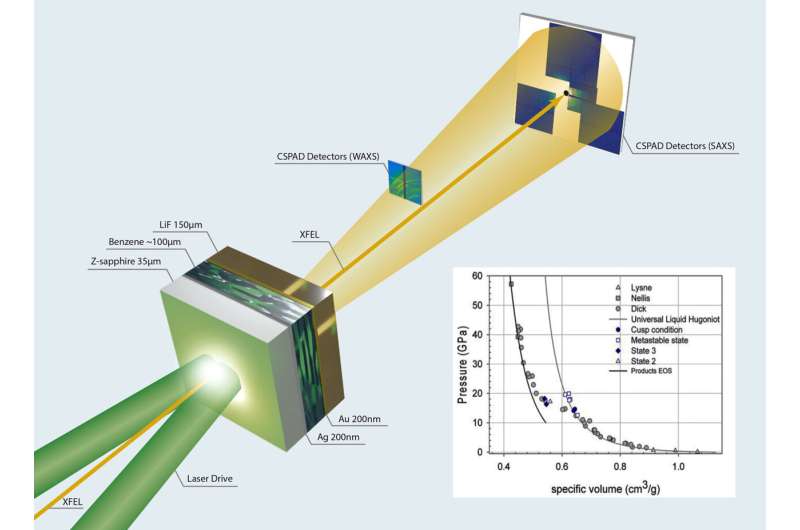A shock-induced mechanism for the creation of organic molecules

Complex carbon-based molecules are everywhere in the Cosmos. How many of these molecules are formed is still something of a mystery, particularly for carbon molecules formed by nature on primordial Earth that gave rise to life on this planet.
Researchers at Los Alamos National Laboratory, using a laser-driven compression technique and x-ray diffraction interrogation at the Stanford Linear Accelerator (SLAC) facility in California, have recently discovered a mechanism for the formation of complex carbon sheet-shaped solid molecules in liquid benzene, a common hydrocarbon, that could unravel some of the carbon formation mystery.
"Using x-ray diffraction and small angle x-ray scattering measurements of liquid benzene shocked to 55 gigapascal (roughly eight million pounds per square inch) we were able to see formation and crystalline structure of the shock-driven reaction products at nanosecond timescales," said the project's principal investigator Dana Dattelbaum. "Chemical reactions in benzene under these extreme conditions yielded a complex mixture of products composed of novel carbon and hydrocarbon allotropes."
An allotrope is two or more different physical forms of an element. Graphite, graphene, and diamond are all allotropes of carbon. Benzene, a ring-shaped molecule that consists of six carbon and six hydrogen atoms, is primarily used to make other chemicals, mostly ethylbenzene, a precursor to styrene, used to make polymers and plastics like polystyrene.
One hypothesis for the formation of life on earth is supported by the theory that asteroid and comet impacts provided a mechanism for complex carbon-based molecule formation, a key building block of life, due to the extreme pressures and temperatures in a shock wave. This research shows how carbon evolves from the simple molecule benzene under shock compression. There have been several works that have looked at this problem from a theoretical approach, but these are the first in situ measurements of benzene's evolution to carbon under shock using high brilliance x-rays.
In this study, researchers used a laser to shock a benzene sample and timed a coherent pulsed x-ray probe from the Linac Coherent Light Source x-ray free electron laser at SLAC to obtain the structure of the products forming as benzene transforms under shock loading. The study, using high brilliance x-rays to "see" inside the materials published today in the journal Nature Communications, found expanded sheet-like structures of carbon in clusters similar to high explosives.
"Understanding chemical reactivity, bond breaking and product formation, is linked to an understanding of how explosives initiate and release energy. Work like this helps the Laboratory develop a better understanding of mechanisms and kinetics of chemical reactions in extreme conditions relevant to planetary impact, explosives detonation and nuclear weapons applications for predictive model development," said Dattelbaum.
"Discovering new forms of carbon and mixtures of allotropes formed in these extreme conditions, being able to probe optically opaque conditions with x-rays for the first time in shock driven reactions, in many ways has been a holy grail dating back to the early shock physics work that started with Manhattan Project," added Dattelbaum.
More information: D. M. Dattelbaum et al, Carbon clusters formed from shocked benzene, Nature Communications (2021). DOI: 10.1038/s41467-021-25471-0
Journal information: Nature Communications
Provided by Los Alamos National Laboratory





















